HP Veer 4G Review
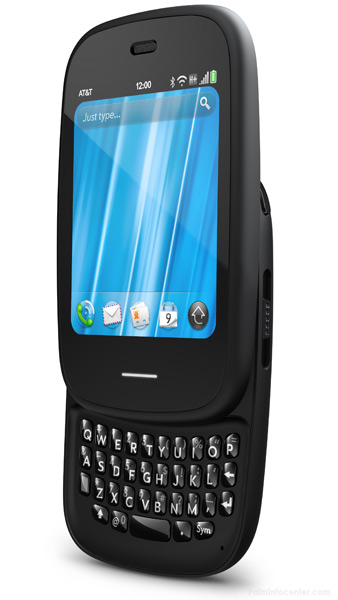 By: Kris Keilhack
By: Kris KeilhackJune 17, 2011
Packaging & Box Contents
I was a bit surprised to see HP carrying on with the rectangular Palm-style rigid cardboard box. The box is adorned in the standard AT&T blue, orange and white colors, which is starting to look a bit dated, as it reminds me too much of the old Cingular days. Nevertheless, the packaging is quite nice for a budget-oriented device.
In addition to the Veer itself, the box contains the standard documentation and paperwork, a mediocre 3.5mm stereo headset, and, tragically, the magnetic microUSB cable and 3.5mm headphone jack adapter. Sadly, Palm's classy "Designed in California" text has been removed.
The bundled USB AC adapter is still amusingly branded as "Palm" which is the only visible place on the hardware where the old logo carries over. "Palm" still does appear in a few spots throughout WebOS 2.1.2, however. Unsurprisingly, the Veer is adorned with HP and AT&T logos but nothing indicating Palm or, somewhat surprisingly, WebOS.
Form Factor & Build Quality
My initial impression out of the box was that this thing is impossibly tiny. After nearly a month of use, I must admit to still being shocked at how much HP has managed to cram into such a small package. I was expecting something along the lines of a reduced-size Pre but I was not expecting anything this Lilliputian! The Veer can hide completely under a credit card and can slip safely into a shirt pocket without a moment's hesitation. Without a doubt, this little gizmo is the best execution yet of Palm's "river pebble" theme as first seen at CES 2009 with the original Palm Pre. Despite my fondness for large-screen behemoth handsets, I simply must confess that the Veer is a very pleasant device to hold in the hand. It has sleek yet gentle curves, pleasant contours and general soothing aesthetics. Indeed, I found myself walking around carrying the little fellow in my hand and marveling at how easy it is to use one-handed with the slider closed. The entire exterior is coated with a lovely soft-touch paint that does not suggest it will pull a Zire 72 and peel off after a few weeks' use. The Veer is the anti-Droid, in every sense of the term. Come to think of it, it's the antithesis of nearly every modern smartphone which, depending on your usage habits and personal preferences, can be both a good and bad thing.
One of the biggest criticisms lodged at the current stable of WebOS devices has been the sub-optimal build quality. While we saw a few furtive steps on the road to quality recovery with last year's Pre Plus and Pre 2, I am glad to report that the Veer is leaps and bounds ahead of past Palm devices in this regard. There is no twisting to the keyboard when the slider is extended and only the tiniest hint of a wobble. No flimsy port doors are in attendance (more on this below) and the device's handful of external buttons feel fantastic, even after near-daily use over the past month. I have no worries that this little phone's power button will collapse or become unresponsive like my Palm Vx, Tungsten T5, and Palm TX did in years past. The volume keys in particular feel especially solid. They don't protrude too much, they are not too deeply recessed and they don't wiggle or rattle. Again, after on and off testing throughout the month of May, the Veer looks and feels brand-new.
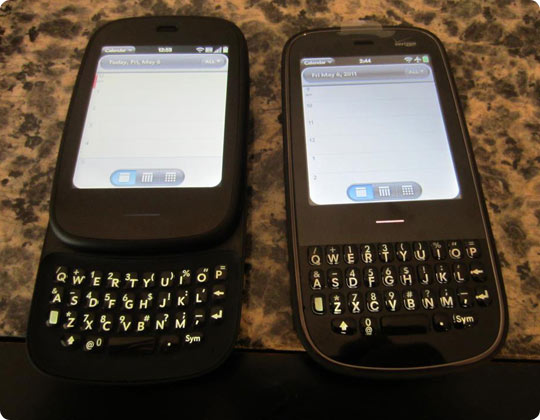
I do worry about the long-term health of the exposed contacts on the sync/charge port. I have serious doubts the contacts will survive over the long term, especially when used extensively by sweaty, grimy hands or when the phone is carried loose in a pocket and likely to come in contact with keys, change and other miscellaneous pieces of pocket fluff. Also, the silkscreened HP and AT&T logos on the backside appear to be fading slightly after a little over a month's use in my sweaty hands.
As you may have gathered from the box contents description, it's true that the Veer cannot charge and have a headphone or headset connected simultaneously. Only one past Palm device--the all-but-forgotten Treo 800w -- required users to choose between connectivity and charging. Of course, the Veer's tiny size and robust Touchstone dock and Bluetooth wireless capabilities mitigate the issue somewhat but this is still certain to be a deal-breaker for some. More so than any other aspect of the device, the Veer's abandonment of all industry-standard connectors would mark the device off of my list at any price. I try to keep all of my devices standardized on microUSB whenever possible. It's encouraging to know that one can travel light nowadays and keep smartphones, certain tablets and most Bluetooth headsets charged via a single microUSB cord or AC adapter. Had HP elected to omit the 3.5mm headphone jack from the Veer I could probably live with the omission, as every past Palm smartphone until the Treo Pro lacked 3.5mm connectivity. But the omission of microUSB on the Veer is a fatal blow to the device's chances of gaining any traction in an industry where only Apple's proprietary iDevice connector has the clout to challenge USB.
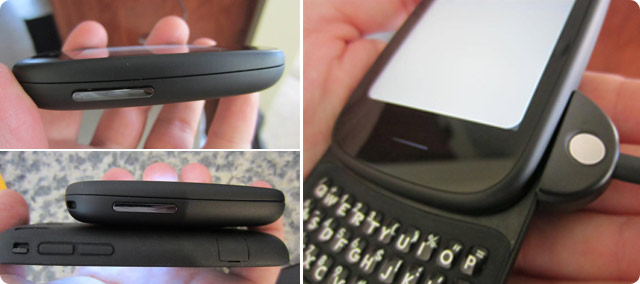
Looking around the top panel of the device , the location of the lanyard loop would seem an ideal spot to cram in a 3.5mm headphone jack or a microUSB. Even if such an addition enlarged the dimensions of the Veer slightly, it is a compromise I feel that many would be glad to make. Again, I could live with the loss of one or the other--but not both.
I suspect many users are like myself and could deal with perhaps one of these two shortcomings. But having to deal with an easily-lost proprietary charging plug, no standard headphone jack, no removable battery and no expandable storage are too many sacrifices in a single modern smartphone. Those are four major deal-breakers compared to BlackBerry or Android hardware and two major shortcomings compared to Apple's devices. Additionally, I also do not see HP's target audience of tweens, teens, and twenty-somethings (many of which will likely be female) having the desire or devotion necessary to keep up with a proprietary adapter just so they can use their headphones or plug the Veer into a stereo system. Even more critically, I can just imagine the feeling of panic this would instill if I were on a trip and faced with a lost microUSB cord and rapidly dying Veer battery. The fixed internal battery makes this situation even more critical and is the single biggest crushing blow to the Veer's hopes for mass-market success. While surrounding oneself with a handful of Touchstone inductive charging docks can mitigate the Veer's small battery capacity and proprietary charger, it will also quickly bump the user's total investment in the platform to a point where the Veer's affordability is rendered moot.
Ultimately, I can easily foresee many potential buyers immediately walking away when learning of the nature of the charger. Even more damaging to HP's fortunes with their carrier and retail partners, I have a sneaking suspicion a lot of new Veer owners may end returning their new devices shortly after purchasing it once they learn that the device is not directly compatible with any headphone or charger in the household.
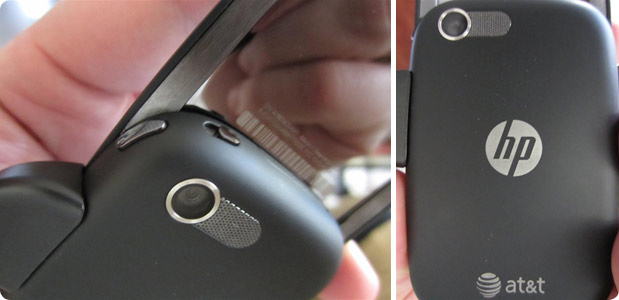
Camera & Speaker
I was disheartened to see that in addition to microUSB, a removable battery and a 3.5mm headphone jack, another casualty in HP's downsizing has been the camera's LED flash. Judging by a few quick test pictures, the Veer's 5mp camera is another area that greatly surpasses the Pixi's feeble 2mp camera, though I must admit that I would have a hard time giving up an autofocus smartphone camera lens if I had to switch to a WebOS device for daily use. Once again I am presented with a dual deal-breaker scenario with the Veer--the loss of autofocus as well as camera flash would be too great of a sacrifice to make. On the bright side, it is nice to have lightning-fast camera response compared to my Droid X's sluggish autofocus lens. However, HP has a long way to go before they smartphones' sensors can equal the cream of the crop employed by Apple, Nokia, Motorola and the other heavyweights in this field. Still, for a device of the Veer's diminutive stature, the camera is capably of capturing (barely) satisfactory still image capture provided the user remains in well-lit environments at all times. I was quite disappointed to see such a barebones, primitive camera application. The quality of the video recording , while vastly better than an old Palm OS Garnet device, was downright atrocious compared to any modern smartphone I have used in the past three years, with the quality of its VGA videos far worse than what I had on a point & shoot camera 6 or 7 years ago.
For such a tiny device, the integrated speaker is passable but certainly won't set any records for clarity or volume. I still vividly remember the days less than a decade ago when much larger cell phones didn't have integrated speakerphones, so I cannot be too terribly critical of the Veer's performance. During a series of test calls over the speakerphone during my time with the device, callers frequently reported I was a bit distant and muffled sounding. When navigating AT&T's voicemail setup menu or an automated banking system, the system's voice prompts were occasionally distorted when on speaker. I had no issues when using the device on the ear speaker as it delivered crisp, though slightly tinny sound. I think the old Centro still holds the record for the best speakerphone quality on a "Palm" device.
The internal vibration is significant stronger on the Veer than on the Pixi. Thankfully, the Pre's nifty rear mirror has been carried over, though I still don't know if it's intended more for self-portrait compositions, applying makeup, or is simply an aesthetic choice.
Keyboard
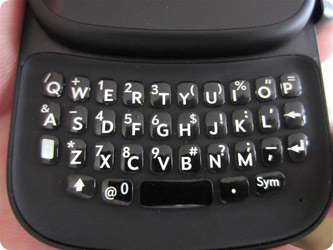 The much-beloved traditional Palm "smile" keyboard is back and basically in fine form. After all these years, I still prefer the traditional Treo key layout over any other smartphone. The reduced width of the keyboard compared to the Pre is definitely noticeable but something easily adapted to after a few minutes of typing. I still miss the contrasting orange numbers from the original Pre keyboard but, like the center button, I have a feeling those are not coming back any time soon. One huge improvement over my Pixi Plus is that the Veer has bright, consistent LED illumination across the full width of the keyboard. My Pixi is brightest in lower left corner with the top corners being rather dim. I cannot stress enough what a difference this makes when using the device in a marginally dark environment. For years Palm's devices suffered from uneven, inadequate key illumination, so this is a small but greatly encouraging touch that demonstrates HP's commitment to quality even on their entry-level devices.
The much-beloved traditional Palm "smile" keyboard is back and basically in fine form. After all these years, I still prefer the traditional Treo key layout over any other smartphone. The reduced width of the keyboard compared to the Pre is definitely noticeable but something easily adapted to after a few minutes of typing. I still miss the contrasting orange numbers from the original Pre keyboard but, like the center button, I have a feeling those are not coming back any time soon. One huge improvement over my Pixi Plus is that the Veer has bright, consistent LED illumination across the full width of the keyboard. My Pixi is brightest in lower left corner with the top corners being rather dim. I cannot stress enough what a difference this makes when using the device in a marginally dark environment. For years Palm's devices suffered from uneven, inadequate key illumination, so this is a small but greatly encouraging touch that demonstrates HP's commitment to quality even on their entry-level devices.
Out of all of the current crop of WebOS devices, I still prefer the Pixi's flush-mounted, "clicky" keys but there is certainly nothing wrong with the Veer's keyboard. In fact, after 3-4 days of usage, I had adapted to the smaller keyboard and could type on it almost as well as I could on my Pixi Plus. I am no great fan of virtual keyboard or alternate input methods such as Swype, and I only live with them due to having a desire for the largest possible screen size in a smartphone. In this era of all-touchscreen candy-bar smartphones, it's refreshing to see another real QWERTY entry, especially at this price point and segment of the market. That said, I still would like to see HP take a crack at a landscape slider device.
About the only major complaint I can make about the Veer's keyboard area is that the lip at the very bottom of the device is still a bit sharp when the slider is open. Also, I still miss having a backlit space bar is still not backlit as it was on the old Treo 700p and earlier devices. Thankfully, the Veer may have a myriad of other issues relating to its tiny stature but the keyboard is thankfully not one of them.
Screen
It's quite a challenge to go from a 4.3" 854x480 screen capable of 16 million colors on my daily driver (a Motorola Droid X) to a 2.6" 320x400 screen capable of 262k colors. To be brutally honest, I would never consider a device with a screen size like the Veer for my primary smartphone. I draw the line at 4" with a physical keyboard or 4.3" with a virtual keyboard and I am eagerly awaiting the upcoming batch of 4.5" screen super phones, as I feel that is the upper limit of pocket-ability and usability for most users. Nevertheless, I persevered longer than I expected with the Veer for testing purposes.
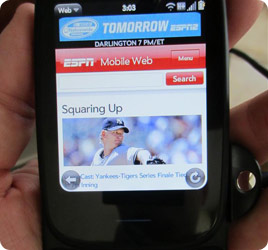 The omnipresent gesture area is still around and remains unchanged. Much like the silkscreen Graffiti area on Palm OS devices, this relic from another era continues to infuriate me greatly. I feel that the gesture area exists only because Palm could not afford or did not want to spec a larger LCD on the original Pre. The gesture area merely serves to gobbles up space that could otherwise be used to bump up the screen's size and resolution. For future versions of WebOS, any necessary gestures could (and should) be accomplished onscreen or perhaps in a RIM Playbook-style bezel space. As the imminent launch of the TouchPad tablet certainly illustrates, HP is comfortable moving to a gesture area-free future. As far an screen size gains realized in future Veer sequel by the removal of the gesture area, I feel that a moderate bump to a 320x480 2.8" screen would make a world of difference in making the Veer a device capable of genuine productivity. Standardizing WebOS devices on 320x480 on the low end would also reduce the level of screen resolution and game compatibility fragmentation currently plaguing the WebOS ecosystem.
The omnipresent gesture area is still around and remains unchanged. Much like the silkscreen Graffiti area on Palm OS devices, this relic from another era continues to infuriate me greatly. I feel that the gesture area exists only because Palm could not afford or did not want to spec a larger LCD on the original Pre. The gesture area merely serves to gobbles up space that could otherwise be used to bump up the screen's size and resolution. For future versions of WebOS, any necessary gestures could (and should) be accomplished onscreen or perhaps in a RIM Playbook-style bezel space. As the imminent launch of the TouchPad tablet certainly illustrates, HP is comfortable moving to a gesture area-free future. As far an screen size gains realized in future Veer sequel by the removal of the gesture area, I feel that a moderate bump to a 320x480 2.8" screen would make a world of difference in making the Veer a device capable of genuine productivity. Standardizing WebOS devices on 320x480 on the low end would also reduce the level of screen resolution and game compatibility fragmentation currently plaguing the WebOS ecosystem.
Screen size and resolution aside, the Veer's screen is significantly better than the Pixi Plus' LCD. HP has definitely spec'd a screen that makes the most of its limited resolution: blacks are blacker, colors are richer, and the Veer handles motion in fast action games better with less ghosting than the Pixi. With both devices cranked to the max, the Veer's screen is tremendously brighter than the Pixi. I do not have any devices in the Pre family handy for testing, but the Veer's LCD definitely seems to be better than what I have seen on any other WebOS device. In fact, while testing the Veer I had a flashback to the Treo to Centro transition in 2007. Back then, Palm made up for the Centro's smaller screen size by boosting its clarity, color reproduction and brightness.
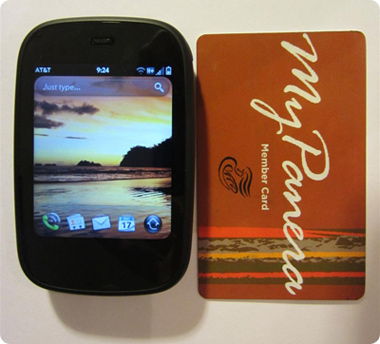 The firmness and durability afforded by the Veer's Gorilla Glass screen coating cannot be understated. Despite the small surface area of the screen, finger gestures are smooth and effortless over the coated glass. If the original Pre had been built like the Pre 2 and Veer it would likely have fared far better in its initial reception. While I have not tested out a Pre 2, the Gorilla Glass the Veer a durable feel that belies its compact dimensions. I would have no reservations carrying this thing "naked" in my pocket, aside from the aforementioned worries about the exposed charger contacts.
The firmness and durability afforded by the Veer's Gorilla Glass screen coating cannot be understated. Despite the small surface area of the screen, finger gestures are smooth and effortless over the coated glass. If the original Pre had been built like the Pre 2 and Veer it would likely have fared far better in its initial reception. While I have not tested out a Pre 2, the Gorilla Glass the Veer a durable feel that belies its compact dimensions. I would have no reservations carrying this thing "naked" in my pocket, aside from the aforementioned worries about the exposed charger contacts.
As I mentioned above, the Veer is imminently usable one-handed as far as web browsing or doing any task not involving text input. The Gorilla Glass coating only helps in this regard, which I will discuss more below. In addition, landscape-oriented activities such as web browsing, video watching or playing Angry Birds because incredibly more satisfying without having to deal with an exposed keyboard in the way. However, the lack of any kind of on-screen input for WebOS smartphones is really becoming quite distressing. Despite the minuscule screen, it would still be nice to have the option of some Graffiti 1 finger strokes or robust speech-to-text dictation capabilities!
OS & Performance
Out of the box, the Veer is running HP WebOS 2.1.2. Out of the 8GB of internal storage present, a bit over 6.0GB remains available immediately for user storage. There's no arguing about HP's claim that the Veer mitigates nearly all of the Pixi's performance issues. Everything is so much snappier and responsive, whether gaming or just during general day to day navigation throughout WebOS. Doubling the RAM and moving to a newer CPU that is 200Mhz faster has certainly addressed most of the performance complaints with the older WebOS devices. The positive experience with the Veer gives me a bit of optimism that the Pre 3 and TouchPad will handily be able to push many more pixels around onscreen.
Even so, even with significantly fewer pixels to push around than any other comparable smartphone currently on the market, things on the Veer still feel a step or two slow compared to the latest crop of Apple iOS devices or 1Ghz+ Android super phones. I remain amazed at how WebOS seems to vary from day to day and how it takes about as long to open the browser or the calendar app as it does a complex game. I would also like to be able to dial down on the various card transitions (pop-ups, zooming etc) in hopes of gaining a bit more performance or battery savings.
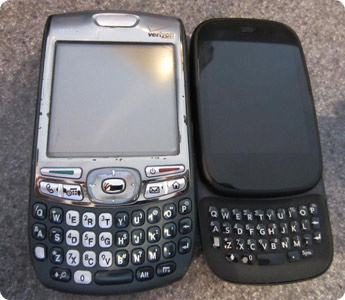 Despite its tiny size, the Veer remains a multitasking champ. It certainly bests the original Pre and all Pixi models and appears to multitask as well or better than any Pre Plus I have ever used. I had over 41 cards open simultaneously and did not experience the dreaded "too many cards" out of memory message.
Despite its tiny size, the Veer remains a multitasking champ. It certainly bests the original Pre and all Pixi models and appears to multitask as well or better than any Pre Plus I have ever used. I had over 41 cards open simultaneously and did not experience the dreaded "too many cards" out of memory message.
One thing that I vehemently oppose in the Android world is the wide variety of handset manufacturer skins such as Motorola's Blur, Samsung's TouchWiz and HTC's Sense. They generally make devices more sluggish, buggier and horribly delay individual OS updates. However, in the walled garden of WebOS, I almost feel that HP might have been wise to offer a switchable "dumbed-down" UI for the Pixi. A lot of the WebOS UI elements were feeling pretty cramped on the Pre's 3.1" screen and they've even less intuitive on the smaller, lower-resolution Veer screen. I often had a hard time quickly toggling the upper left drop-down prefs or the upper right network menus, for instance. I would also like to see HP eventually abandon the rounded corners of the apps or at least offer the option of the native apps going completely fullscreen. The omnipresent status bar at the top of the screen gobbles up space that would be greatly appreciated when web browsing or viewing a document in QuickOffice in portrait mode, for example. While I'm at it, I also must say that it's well past time for HP to better implement landscape mode across the OS. Even if text input is not possible, the Veer feels fantastic in-hand when used sideways with the slider closed--let's go ahead and make this an OS-wide option like it is on Android.
Network connectivity, aside from the usual gripes about AT&T's coverage gaps, is quite good. The HSPA+ is truly a nice boost (even though I still consider something like HSPA+ more along the lines of 3.5G instead of true 4G) and a definite step up from Verizon's mighty but slow EVDO 3G infrastructure. Indeed, download and upload speeds were thankfully never an issue with the Veer.
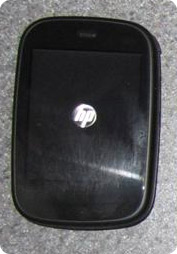 Hands free wise, Voice dialing is FINALLY here, courtesy of Nuance, and it's actually baked into the OS, not a flaky add-on like we had in the Palm OS days. It's quite ironic that it took nearly five years since Palm announced their support of California's Hands-Free calling bill for a device to ship with this feature standard...and it's not even Palm-branded. Again, this is a nice step but far behind the various voice command and voice-to-text capabilities available in Android and iOS.
Hands free wise, Voice dialing is FINALLY here, courtesy of Nuance, and it's actually baked into the OS, not a flaky add-on like we had in the Palm OS days. It's quite ironic that it took nearly five years since Palm announced their support of California's Hands-Free calling bill for a device to ship with this feature standard...and it's not even Palm-branded. Again, this is a nice step but far behind the various voice command and voice-to-text capabilities available in Android and iOS.
Battery Life, Exhibition Mode & Miscellaneous
After nearly two hours of sporadic testing in my first full day with the Veer (no BT, no wi-fi, 10 minutes of Angry Birds, 10 minutes of web browsing over HSPA, 5 minutes of voice calls, screen either at maximum brightness or 1/2) I had about 80% of my battery remaining. Continued use over the past month (mostly media, gaming and web browsing) has had no noticeable impact in battery life. Of course, I would still worry about the device's long-term viability due to its fixed internal battery, as I make it a rule of thumb whenever possible to not purchase devices with sealed or fixed batteries.
Since I do not possess a Touchstone dock, I was unable to test out the Exhibition mode to its full capability. Nevertheless, it can be manually toggled and the user is then presented with the option of having a time display, photo slideshow, or Agenda view. Additionally, the clock mode can be toggled between daytime and nighttime modes. All in all, Exhibition is a very nice, classy and Apple-esque touch, though it is of dubious benefit to anyone not owning a Touchstone dock. I have been a Touchstone fan since its unveiling at CES 2009 and I must say that it would be an absolutely mandatory item for a Veer owner, given the nature of its proprietary sync/charge magnet connector.
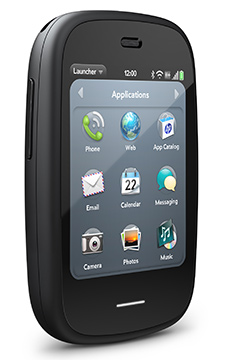 Pricing
Pricing
I usually do not focus on pricing for smartphones unless it involves discussion of the device's full retail, unlocked or non-subsidized price but I feel the Veer deserves special mention. HP's efforts to target younger or first-time smartphone buyers with an "affordable" smartphone are rendered completely null and void not by the presence of smartphones costing $100, $200 or even $300 more than the Veer (already "free" on contract at several retailers), but rather by the increasingly costly data plans from the carriers. To users on a fixed or limited income, their reason for staying with a feature phone are likely due to the $30+/month data plans attached to smartphones.
I feel that a far better strategy to ensure the Veer's success would have been a generous subsidy by HP on the monthly service (much like what Palm did for the free 3G wi-fi hotspot on the Verizon Pre Plus and Pixi Plus). A special AT&T data plan created just for Veer users that would give unlimited SMS, 2Gb of data and a generous allocation of voice minutes for an unbeatable monthly price--or offering unlimited data for the same $15 that would normally get the user 200Mb/month or perhaps even free wi-fi tethering like the Verizon promotion in 2010. Positioning the Veer as a premium offering on the pre-paid carriers would also be another strategy. A device like the Veer that is so unusual and dissimilar as everything else on the market deserves an aggressive, innovative marketing strategy that stands out from the herd. When lined up on the store shelves next to an array of much mightier handsets, the Veer is almost certainly destined for failure like its predecessors failure at the hands of ill-informed sales clerks and more alluring specs in competing devices. But as it stands now in the fiercely cutthroat postpaid market, I do not see anyone but a small number of minimalist diehards living with the Veer's shortcomings while paying the same monthly service fees that would net them an iPhone or powerhouse Android handset from AT&T.
Conclusion
The Veer is a fascinating little proof-of-concept device and quite a marvelous example of what modern engineering prowess can cram into such a small form factor. It also an assuring sign that WebOS 2.x is finally moving forward after the stagnation seen throughout 2010. The problem with the Veer, however, is two-fold and ultimately more endemic with problems within HP/Palm and the WebOS ecosystem in general than it is the Veer's hardware shortcomings.
First of all, the Veer arrives on the market alongside the stillborn, barely-supported Pre 2 and a handful of discontinued first-generation legacy WebOS devices from Palm. Personally, I feel that the Pre 3 or TouchPad would have been a vastly better choice for the torch-bearer for the relaunch of WebOS, with the Veer following shortly thereafter as a cheaper, complimentary device. HP is still paying a dear price for the mistakes and lost opportunities from the previous Palm regime and this seems an odd choice to release at such a critical time for the company and the platform. Everyone likes a lightweight, thin, and stylish phone but when achieving this comes at the expense of all legacy ports and much of the device's functionality, the line has definitely been crossed. The Veer, even if it were more Pixi-like in its port accommodations, would have made for a far tastier piece of dessert than an unsatisfying main course.
As things are right now in June of 2011, the poor little AT&T Veer, much like the Sprint Pre in June of 2009, has to carry the entire WebOS torch alone right now until the TouchPad and Pre 3 arrive sometime later this summer to solidify HP's lineup. It is just too easy to label the Veer (and even the Pre 3) as a stopgap, transitional device, with the TouchPad being the first "true" byproduct of HP's acquisition of Palm.
In conclusion I really feel that the Veer brilliantly answers a question no one was asking while arriving at the worst possible time to market. The Pixi was a perfectly fine form factor for a lower-end WebOS handset and it had all the right ports and a removable battery. The Pixi could have easily and affordably been revamped with a new name and Veer-quality innards and build quality. Instead, vast engineering resources have been spent creating the Veer from scratch that could have been otherwise allocated to bolstering the TouchPad line, further updating WebOS, or sponsoring efforts to drum up developer support.
As an actual device, even setting aside personal preferences such as screen and keyboard size, I cannot recommend the Veer at all due to its major compromises in terms of charging, connectivity, and audio output. However, as a harbinger of better things to come for WebOS under the stewardship of HP, the Veer stand alongside the TouchPad as the brightest glimmer of hope yet for the WebOS platform since its unveiling.
Article Comments
(46 comments)
The following comments are owned by whoever posted them. PalmInfocenter is not responsible for them in any way.
Please Login or register here to add your comments.
RE: Palm 2.0? Research In Motion Tumbles After Another Lousy Quarter
RE: Palm 2.0? Research In Motion Tumbles After Another Lousy Quarter
Also, I still am amazed at how many stores are (still?) selling Playbooks. Or rather, have Playbooks on prominent endcaps for display because I don't think many are being sold! Staples, Office Depot, Offic Max, BB...how so many big retailers could have gotten behind a product so clearly half-baked (arguably the worst high-profile mobile dveice "concept" since the Fooleo) continues to amaze me. And, the Playbook from a company who has never shown much flair for industrial design & zero UI briliance or even an understanding of the consumer market other than saturing every possible carrier with a lot of similar handset designs.
I've long maintained that RIM's success came from being in the right place at the right time and a lot of long-term contracts w/ companies & governments that are utterly dependent on their services. RIM's hardware and OS/UI has always seemed to be running 5 years behind the rest of the industry.
Pilot 1000->Pilot 5000->PalmPilot Pro->IIIe->Vx->m505->T|T->T|T2->T|C->T|T3->T|T5->Zodiac 2->TX->Verizon Treo 700P->Verizon Treo 755p->Verizon Moto Droid + Verizon Palm Centro-> Verizon Moto Droid X + Palm TX
RE: Palm 2.0? Research In Motion Tumbles After Another Lousy Quarter
come on. why would MSFT buy RIM for billions? they just spent billions of dollars and time creating that turkey WP7. why would they waste more billions buying another turkey like BB? "two turkeys do not make an eagle."
and why would MSFT buy RIM OR Nokia? why would they want to alienate and compete against their entire hardware manufacturer customer base? HTC, Dell, Samsung et al. all of those companies that make WP7 handsets? unless you think that MSFT is abandoning their entire mobile business model.
RIM is toast. NOK is toast. WP7 is toast.
RIM is Palm 2.0. some company will pick them up a few years from now for pennies on the dollar just like HP picked up Palm. but who wants an antiquated proprietary OS? or who wants an antiquated hardware manufacturer? what does RIM bring to the table? it will have to be CHEAP. at least Palm had some interesting fresh new software (WebOS) and a few bright people from Apple. what does RIM offer? sure they have some patents but what are they worth? RIM is staffed by a bunch of 50-something inbred engineers from Southern Ontario. not exactly the cream of the crop from around the world.
RE: Palm 2.0? Research In Motion Tumbles After Another Lousy Quarter
Also, I DO NOT expect MS to buy Nokia or any part of them. That was just a wishful thinking rumor by BGR. They already have a 'strategic investment' partnership with them.
So you'd have Nokia cranking out Windows Phone hardware and RIM supplying whatever they do best. MS can pick up RIM if the price is right, fold the hardware division, and eventually migrate all of the BB-using enterprise & gov customers over to Windows Phone bit by bit.
RIM & Nokia are toast, yes. But MS can never fully be considered out of the game, at least not for the next decade or so.
All we need to do is to pull up the list of Palm suitors circa January 2010, remove HP & RIM from the list (naturally), maybe add a few new names to the mix and you have the list of potential candidates to buy RIM.
Pilot 1000->Pilot 5000->PalmPilot Pro->IIIe->Vx->m505->T|T->T|T2->T|C->T|T3->T|T5->Zodiac 2->TX->Verizon Treo 700P->Verizon Treo 755p->Verizon Moto Droid + Verizon Palm Centro-> Verizon Moto Droid X + Palm TX
RE: Palm 2.0? Research In Motion Tumbles After Another Lousy Quarter
MSFT has MS Exchange and EAS. and they have WP7. not sure why they need to spend billions and billions to buy RIM. they might be interested in the scraps for cheap though. ie some patents etc. RIM is in a classic death spiral.
RE: Palm 2.0? Research In Motion Tumbles After Another Lousy Quarter
Link?
Pat Horne
RE: Palm 2.0? Research In Motion Tumbles After Another Lousy Quarter
Microsoft would buy RIM because they're stupid. Windows Phone 7 is an abomination and will fail compared to the hordes of superior Android phones on the same hardware. This will take less than a year for Microsoft to realize the platform really is dead. Ballmer will panic and outbid Google for RIM's carcass - probably for a cool $10B when the company has a market value of $6B.
If you ask why Microsoft would do this, think about why they bought Skype. Poor management. Skype is an unprofitable company that can't make money even with enormous economies of scale. Any services Microsoft plans to incorporate Skype into either already has video conferencing (Windows Live, Messenger) or could have bundled the software. They didn't have to buy the company. Same thing happened with Yahoo - they almost bought the company for $40B back in 2008 (which Yahoo eventually turned down as "too low" - ****ing unbelievable), yet now they have an agreement where Yahoo uses Bing for its search. They get the search revenue without the rest of unprofitable Yahoo. This happened in spite of Ballmer trying to buy the company. It happened again with the talks for Microsoft to buy Nokia and culminating in a licensing agreement. All of these companies - Nokia, Yahoo, and Skype have shitty, dying businesses that Microsoft wants to buy because it's a flailing carcass with too much cash from enterprise sales with companies that run Exchange on XP machines.
THAT'S why they'll try to buy RIM. Because they're ****ing stupid.
RE: Palm 2.0? Research In Motion Tumbles After Another Lousy Quarter
Another potentially bad move by MS is they are going to "Windows Phone-ify" & dumb-down Windows 8 with the Metro UI. Just when we got a reasonably fast, stable, and mostly clutter-free OS in Win 7, they're going to start plumping it up again with multiple interfaces/UI modes etc.
Trying to "finger-friendly" mobile UI-ify a desktop OS designed around a keyboard & mouse reminds of of how the HTC HD2 was trying to put a finger-friendly UI atop the WinMob 6.5 pig. Sure it was snazzy when you first booted it up. Then once you delve one or two layers deep you get into the crude native UI. And as far as tablets? Please. Android is a bad enough power and resource hog on a tablet. Anything Windows-related will be an utter disaster on a tablet.
Pilot 1000->Pilot 5000->PalmPilot Pro->IIIe->Vx->m505->T|T->T|T2->T|C->T|T3->T|T5->Zodiac 2->TX->Verizon Treo 700P->Verizon Treo 755p->Verizon Moto Droid + Verizon Palm Centro-> Verizon Moto Droid X + Palm TX
RE: Palm 2.0? Research In Motion Tumbles After Another Lousy Quarter
i sold my MSFT stock years ago. they stopped innovating too. the only MSFT products i use now are Windows 7 and Office (Excel and Word). and if they screw those up i will switch to Chrome OS and Google Docs.
http://blogmaverick.com/2010/12/10/am-i-living-the-google-lifestyle/
RE: Palm 2.0? Research In Motion Tumbles After Another Lousy Quarter
Suggesting that RIMM is a takeover target certainly sounds like a heroic call, but seriously, do you really think any of the companies on that list would buy RIM? I don't.
Let's walk through them:
HP? They're still trying to integrate Palm, and they've made a major commitment, for better or worse, to WebOS. And CEO Leo Apotheker has declared an intention to build up the company's position in enterprise software. Buy RIM? No way.
Dell? Ha! The company is ratcheting up their spending on the data center, and trying to move away from being strictly a device company. Highly doubtful. Would RIM plus Dell be any more competitive with Apple and Android than RIM alone?
Oracle? Larry Ellison does not want to be in a business as consumer-dependent as this one has become. Not Oracle's style.
Cisco? Get real. The market would run John Chambers out of town. Chambers in the past has flat-out denied any interest in making handsets. The Street wants the company to focus on the core, not to tack on a handset company. No.
Microsoft? A well-worn rumor, but hard to believe Steve Ballmer would buy RIM while trying to make a go of the deal with Nokia. I suppose you could tie them all together – RIM, Nokia and Windows Phone – and pretend that you really had something. But I find such a possibility hard to believe. That would be like thinking you could build a really nice raft by tying three bricks together.
SAP? Now, that's just ridiculous. What does SAP know about hardware, or handsets, or Canada? No. Nein. Not happening.
Canadian pension funds. Well, I have no idea how Canadian pension funds think. Who knows? But do you really want to own the stock on that theory?
Look, all of this talk about someone buying RIM fails to recognize the basic underlying dynamics of the market. Apple and the Android gang are simply wiping out the rest of the players in the handset market. RIM, HP, Nokia, Microsoft…it will not be easy for any of them to stay relevant in the rapidly evolving market for mobile devices. Would you actually want to go out and buy a handset company that is hemorrhaging market share? At today's close, RIM had a market cap of $15 billion; with even a modest premium such a deal could cost a buyer close to $20 billion – and leave them with the task of turning around a plummeting business. I simply don't think that is a likely scenario.
True, even Palm found a buyer – but for $1.2 billion, not $20 billion. Some day, a bottom-fisher could take a flier on RIM. But I don't think we're anywhere near the bottom.
RE: Palm 2.0? Research In Motion Tumbles After Another Lousy Quarter
RE: Palm 2.0? Research In Motion Tumbles After Another Lousy Quarter
Nice bullet list Gekko Reminds me of Time Warner buying AOL about 2-3 years after it's zenith and as the sun was clearly setting. I thot, why do they want that dinosaur. RIM is about the same it seems. Big market share and no future.
Pat Horne
RE: Palm 2.0? Research In Motion Tumbles After Another Lousy Quarter
"how so many big retailers could have gotten behind a product so clearly half-baked (arguably the worst high-profile mobile dveice "concept" since the Fooleo) continues to amaze me."
Because it's Blackberry. Many retailers stock only on brand name, not value, usefulness, or anything else.
@Gekko:
"and why would MSFT buy RIM OR Nokia? why would they want to alienate and compete against their entire hardware manufacturer customer base?"
What manufacturer base? Who is seriously producing WP7 phones? Dell turned in a half-hearted effort, same for Samsung, HTC is doing a little better--but 90% of their effort remains with Android. WP7 is a ghost right now. Nobody cares about it, and it's within a hair's breadth of becoming a DOA operating system on par with WebOS.
Now I'm not saying it's smart. But if they follow the current strategy, WP7 is dead. Period. Buying out another major brand with an established presence like Nokia or RIM would make a certain amount of sense (if you're desperate enough), and might enable Microsoft to stave off death for awhile yet. No guarantees where it goes from there, though. Neither Nokia nor RIM is exactly what Microsoft needs to prosper in the smartphone space. Well, to be honest what they need to prosper is a time machine, so that they can go back and actually implement the things that should have been obvious to them with WM 6.1, like an online app market. But that's a whole other rant.
RE: Palm 2.0? Research In Motion Tumbles After Another Lousy Quarter
RIM Developers Defecting to IPhone, Android
By Devin Banerjee and Hugo Miller - Jun 27, 2011 12:01 AM ET
RE: Palm 2.0? Research In Motion Tumbles After Another Lousy Quarter
http://www.pcmag.com/article2/0,2817,2387558,00.asp?kc=PCRSS03079TX1K0000585
Pilot 1000->Pilot 5000->PalmPilot Pro->IIIe->Vx->m505->T|T->T|T2->T|C->T|T3->T|T5->Zodiac 2->TX->Verizon Treo 700P->Verizon Treo 755p->Verizon Moto Droid + Verizon Palm Centro-> Verizon Moto Droid X + Palm TX
RE: Palm 2.0? Research In Motion Tumbles After Another Lousy Quarter
1. Go back and shore up its core business and innovate specifically around even more secure settings for enterprise, government and SMB.
this is too little too late. Microsoft EAS security or equivalent is now good enough for most companies. no need anymore for a BB server for security or device management.
2. Exit the consumer business.
this would be suicide. huge loss of revenue, reversal of what little momentum they and economies of scale and a further stagnation and atrophy of their ecosystem. employees are pushing for iPhones, iPads, and Androids in the enterprise because they want them and they have consumer features. people don't want to fumble with two devices. enterprise is finally figuring out that it makes sense to let employees buy/pay for/bring/manage/support/plug in with their own device.
3. Change leadership at the top.
this i can't argue with.
http://www.joyoftech.com/joyoftech/joyarchives/1556.html
4. Consider Being Acquired.
they'd be LUCKY to get acquired at anything near current valuations of $15B.
RE: Palm 2.0? Research In Motion Tumbles After Another Lousy Quarter
5-6 years ago it was a big deal to be issued a BB by your employer. 2-3 years ago it was sort of a mild bummer to be issued a BB. Nowadays everyone is wanting to ditch their archaic BBs as fast as possible, and ideally you can bring your own WP7/Android (sometimes)/iOS device and usually be taken care of. Middle-aged Execs LOVE their iPads!
Pilot 1000->Pilot 5000->PalmPilot Pro->IIIe->Vx->m505->T|T->T|T2->T|C->T|T3->T|T5->Zodiac 2->TX->Verizon Treo 700P->Verizon Treo 755p->Verizon Moto Droid + Verizon Palm Centro-> Verizon Moto Droid X + Palm TX
RE: Palm 2.0? Research In Motion Tumbles After Another Lousy Quarter
Let's rewind a few years. Picture yourself sitting in an executive briefing at Research In Motion. You'd hear Mike Lazaridis unequivocally state time and time again that BlackBerry smartphones would never have MP3 players or cameras in them because it just does not make sense when the company's primary customers were the government and enterprise. "BlackBerry smartphones will never have cameras because the No. 1 customer of ours is the U.S. government," Mike Lazaridis would say in meetings. "There will never be a BlackBerry with an MP3 player or camera."
The fact is, that RIM didn't only miss the boat in terms of product features and device trends as we now know, but the underpinnings of the company's consumer failure began all the way back in 2005 with bold statements like these, combined with a lack of research and development in numerous key areas.
Mike Lazaridis would say that the most ridiculous idea was to name a phone with a marketing-derived name, like the Motorola RAZR. "BlackBerry will never do that, it will always be a model number," he said to executives. "A BlackBerry with a name is ridiculous."
"Here we are, as young, brazen people, and we're just like, ‘Mike, you're missing out. There's a trend here; it's a social and collaborative scene in certain media circles'," one former executive said, describing the general feeling among other executives at the company. "Now look at what's happened 4 or 5 years later — an MP3 player, camera, name, all done reluctantly."
RE: Palm 2.0? Research In Motion Tumbles After Another Lousy Quarter
"When I would work with our major carriers, I would have to go to Mike's product development team, and ask what are we going to bring to [redacted]," and it was never a cutting edge product, one former executive told me. There wasn't ever a three-year roadmap. Mike was always focused on small, granular features like how to make the speakerphone in a BlackBerry the best speakerphone on the market. Mike would say that people were going to buy a BlackBerry because of the speakerphone… "because they wouldn't need a Polycom anymore."
The three-year roadmap for RIM products focused on refining the technology in phones had already been released, rather than looking at where to add major new componentry or trying to identify or even shape future trends. "One of the main reasons RIM missed the mark with the browser was because
they were always proud of how little data usage a user would use," a former executive said. "There was no three-year plan at RIM." RIM would be proud of the fact that someone would only use 1MB of data in a month in 2005, and as a result, there wasn't ever any extensive R&D done within the browser space. Over time, that misstep affected BlackBerry tremendously as competing devices began to deliver desktop-like Web experiences. "Mike Lazaridis couldn't imagine that consumers would be spending hours watching and streaming video to their devices, he couldn't understand it," the former exec continued. This is why we don't see RIM excelling in spaces like camera technology, or displays — because the company never even attempted to anticipate the smartphone trends we're seeing today. "RIM is a reactionary company."
I remember going to sit with the CMO of one of the largest wireless carriers, and we would deliver features like "increase battery life by 40%" in the next model, and we would get a blank look on the other side of the conference room. The executives would think, ‘so your telling me with this device I am going to sell 40% less car chargers', there was a blank stare. "They want the flavor of the week, and the carrier's loyalty is to their customers and what their customers want. Then try and delivery that."
RE: nice review
RE: nice review
-Centro still feels the most well-balanced of the 3. It also destroys the other two for PIM, quick data input & recall, and one-handed use. No amount of gesture areas or multitouch pinches will ever beat a row of dedicated hard buttons and a clickable d-pad
-Centro still had the best battery life (from what I can recall) & loudest speaker volume
-Pixi has the best feeling keyboard of the 3 by far as well as the best port assortment. It's also the only one with a camera LED flash.
-Veer blows the others away (especially the Centro) in terms of build quality (love that glass screen)
-Size differences aside, Veer definitely has the best screen of the 3 as far as brightness and color saturation.
-Despite being only .03" bigger, the Pixi's screen somehow always "feels" quite a bit bigger than the Veer's
-Veer is the sleekest looking and most natural/comfortable to use in hand initially, but after extended use it almost feels too small and cramped. Pixi is a nice compromise.
My advice? Stick with the Centro until it completely dies.
Pilot 1000->Pilot 5000->PalmPilot Pro->IIIe->Vx->m505->T|T->T|T2->T|C->T|T3->T|T5->Zodiac 2->TX->Verizon Treo 700P->Verizon Treo 755p->Verizon Moto Droid + Verizon Palm Centro-> Verizon Moto Droid X + Palm TX
RE: nice review
For now I am awaiting the revised Moto Bionic on VZW later this year. It promises to be a dual-core, 4.5" screen superphone with LTE. By the time Android gets to Ice Cream Sandwich it should be approaching a reasonbly decent OS but Google still has a lot of work do for PIM, intuitiveness, and RAM/powermanagement.
The only thing from HP/Palm that I would even remotely consider buying right now is a TouchPad, preferably in a 7" or 8" formfactor but I'll still be extremely curious to test a 10" TP as well. I've been saying since day 1 that WebOS is just crying out to be used on a much larger, higher-res screen.
Pilot 1000->Pilot 5000->PalmPilot Pro->IIIe->Vx->m505->T|T->T|T2->T|C->T|T3->T|T5->Zodiac 2->TX->Verizon Treo 700P->Verizon Treo 755p->Verizon Moto Droid + Verizon Palm Centro-> Verizon Moto Droid X + Palm TX
RE: nice review
major dealbreakers -
1. shitty small display size.
2. laggy buggy delay to open the browser or the calendar app or contacts app.
3. proprietary connectors and silly contraption adapter dongle.
4. lonely tiny island proprietary ecosystem.
need i go on?
RE: nice review
RE: nice review
Cloud
i love the Cloud. i don't miss local syncing one bit. i don't miss fumbling and fighting and remembering and transporting proprietary sync cables. no more having to plug in and sync a few times every day just to make sure i don't lose any data. all of my data is accessible and backed up and moved and stored and transferred automagically over the air wherever i'm at anywhere in the world - instantly. it's a beautiful thing.
RE: Cloud
To me, it was always such a nail-biting endeavor to initiate a Palm OS hotsync. It just seemed like there was always a risk that something would not work. I often wonder if "the younger generation" can truly appreciate how much better it is now than compared to the risks of a Palm OS HotSync.
As long as we are on the subject, what is your response to the concern that keeping our calendar in the Cloud risks privacy intrusion?
RE: Cloud
i feel relatively safe with Google holding my PIM data from a privacy, security, and safety aspect. i doubt that the serious hackers who have the skill to break into Google's servers are worried about my calendar data. but even if they are - they can have it. for my confidential information i do this -
http://androidforums.com/android-applications/15701-best-password-manager-app-4.html#post2177979
75 bucks on eBay for the Veer !?
WebOS has a strong fan community and I find it refreshing among all the Androids and iPhones in the market.
PLEASE HTC, get on the WebOS bandwagon!
Latest Comments
- I got one -Tuckermaclain
- RE: Don't we have this already? -Tuckermaclain
- RE: Palm brand will return in 2018, with devices built by TCL -richf
- RE: Palm brand will return in 2018, with devices built by TCL -dmitrygr
- Palm phone on HDblog -palmato
- Palm PVG100 -hgoldner
- RE: Like Deja Vu -PacManFoo
- Like Deja Vu -T_W







Pretty Good.
I love the part about the Veer answering questions that nobody is asking. Palm has an illustrious history of that. The magnetic connector that they put engineers and investment into, just about says it all. Pretty slick operation, but completely undesirable for an actual user! Palm staff and leadership was either left over to bless us with that, or Palm had this designed when HP bought in. As idiotic as the Treo 800w.
Now if HP will update the OS to handle all the upcoming direct data sharing / syncing with the touchpad, then I could see a niche for a device like this as a companion.
Pat Horne